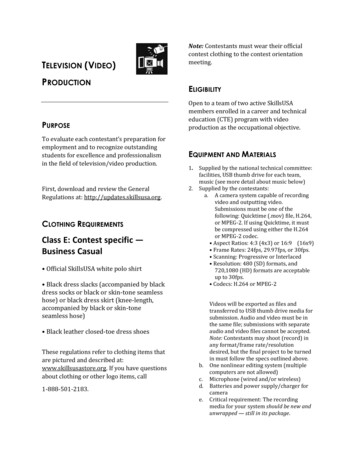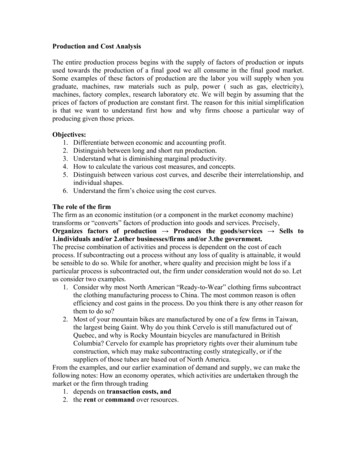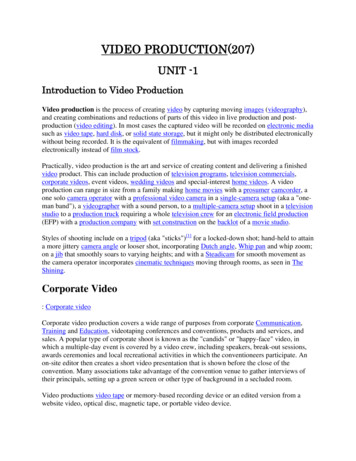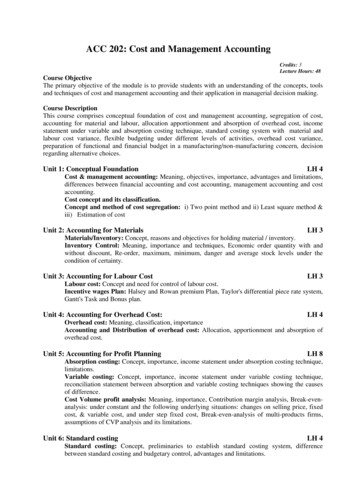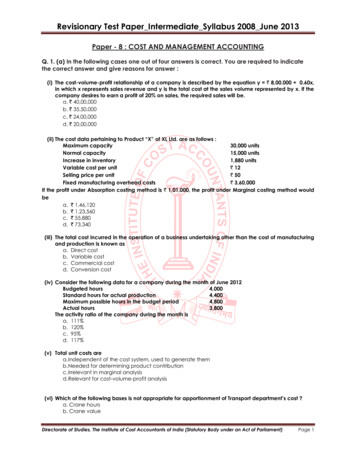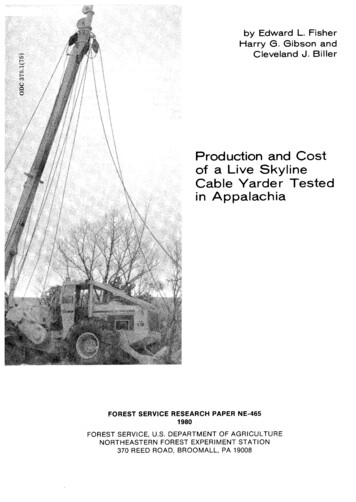
Transcription
by Edward L. FisherHarry G.Gibson andCleveland J. E3illerProduction and Costof a Live SkylineCable Yarder Testedin AppalachiaFOREST SERVICE RESEARCH PAPER NE-4651980FOREST SERVICE, U.S. DEPARTMENT OF AGRICULTURENORTHEASTERN FOREST EXPERIMENT STATION370 REED ROAD, BROOMALL, PA 19008
The AuthorsEDWARD L. FISHER, during this study, was a research industrial engineerin the engineering unit of the Northeastern Forest Experiment Station,Morgantown, West Virginia. He received B.S. and M.S. degrees in industrialengineering from West Virginia University in 1975 and 1978, respectively.He joined the Forest Service in 1975 and in 1980 accepted a teaching position at West Virginia University.HARRY G. GIBSON, during this study, served as project leader of theengineering unit of the Northeastern Station at Morgantown. He received aB.S. degree in mechanical engineering in 1962 and an M.S. degree in engineering in 1969 from West Virginia University. He joined the ForestService in 1966 and in 1978 he became plantation harvesting manager forJari Florestale Agro-Pecuaria Ltda., Brazil. He is now an associate professor of forest engineering at Purdue University.CLEVELAND J. BILLER is a research mechanical engineer with theNortheastern Station in Morgantown. He received a B.S. degree in mechanical engineering in 1967 and an M.S. degree in engineering in 1970 fromWest Virginia University. He joined the Forest Service in 1966.'MANUSCRIPT RECEIVED FOR PUBLICATION 3 OCTOBER 1980AbstractLogging systems that are profitable and environmentally acceptable areneeded in Appalachian hardwood forests. Small, mobile cable yardersshow promise in meeting both economic and environmental objectives.One such yarder, the Ecologger, was tested on the Jefferson NationalForest near Marion, Virginia. Production rates and costs are presented forthe system along with a discussion of the complete operation.
INTRODUCTIONAND ENVIRONMENTALP ROFITABLELY acceptable logging systems are neededin Appalachian forests. These systems shouldbe able to thin even-aged stands, remove individual trees from uneven-aged stands, andharvest mature trees. A critical phase of thelogging operation is transporting logs from thestump to the landing. This phase accounts fora large portion of the total harvesting costusually at least 30 percent-and can result inserious damage t o the environment. Thearticulated skidders and crawlers, currentlyused in Appalachia often damage residualtrees and require a network of logging roads,which are unsightly and a major source of soildisturbance on steep sites.One objective of forest management is developing a logging system that not only operates economically in Appalachian hardwoodstands but also has a less detrimental impacton the environment (primarily by reducingthe number of haul and skidroads) than conventional tractor systems. Cable logging showspromise in meeting this objective.Of the cable systems available, we believethe lighter, less costly systems would be effective in Appalachia (Gibson and Phillips 1973)because :1. Slopes are predominantly convex inAppalachia. In West Virginia and the steeperareas of Pennsylvania, 95 percent of theslopes fit this category. This is true for muchof Appalachia. Smaller cable systems with areach of 1,000 feet or less would minimizethe problems associated with convex slopes.2. Private individuals own most of the forest land and their tracts are of limited size-80percent of the growing stock in West Virginia,typical of Appalachia in this regard, is ownedby private individuals. Small cable systems arehighly mobile and can easily be moved intosmall tracts. These machines also can bemoved on state highways without violatingvehicle standards on height, width, and weight.3. The small cable systems have a lowerinitial cost than large cable systems and thuscan be better matched t o small timber.4. Small cable systems do not require wideroads; this means more land available for treeproduction and lower road construction costsin steep areas where these costs are highest.Also, narrow roads are not highly visible andpose a less serious threat of erosion becauseless soil is disturbed.In this study we used a small, mobile cablesystem to harvest timber on steep Appalachian slopes. We then determined productionrates, costs, and generally assessed damage t othe environment.TEST AREAThe site chosen for harvest was a 62-acretract located within the Jefferson NationalForest near Marion, Virginia. The sale wasplanned by the National Forest under thejurisdiction of the Mount Rogers NationalRecreational Area. A private contractor didthe logging; logs were trucked 52 miles to asawmill in Clinchburg, Virginia. The prescription for all harvesting was clearcutting. Timber harvested was primarily basswood, blackand yellow birch, red and white oak, andsugar maple. There were smaller amounts ofash, hard maple, and cherry. The averagediameter (average of small and large ends) ofthe harvested logs was 15 inches with a minimum top diameter of 8 inches. The averageslope was 56 percent and the maximum yarding distance was 700 feet.
LOGGING SYSTEMEquipment and manpowerFigure 1.-The Ecologger live skyline yarder wasmounted on a 130-horseoower Tree Farmer C6Rskidder.The equipment used in the operation wasan Ecologgerl live skyline yarder (Figs. 1,2),mounted on a 130-horsepower Tree FarmerC6D skidder. The system was equipped with ahydraulically operated yarding tower, guylines, mainline, and skyline. A Maki carriagewas used to bring the logs to the landing.Specifications are given in the Appendix. Thecost of the yarder including the skidder wasapproximately 130,000 at the time of theoperation. This yarder, minus the skidder, cannow be purchased for about 65,000. Otherequipment included a small bulldozer,Prentice 200 loader/mechanical bucker, antwo log trucks. The crew consisted of twchokersetters, one operatorlchaser, one foreman, two fellers, supervisory personnel (fractional time) and two swing men responsiblefor bucking at the landing, loading, operatinga bulldozer in the construction of additionallandings, and hauling logs to the mill. Theyarder was equipped with remote electroniccontrols to enable the operator to unhooklogs at the landing. This innovation allowedyarding to be done by a three-man crew.Description of operationAfter felling, the yarder was set up by fourmen in about 4 hours. This operation included disassembling the set just finished, movingthe machine to the next set, leveling it, extending four guy wires and securing them,rigging the skyline to the first tail tree of theset, and setting the carriage stop at the firstposition.After the set-up had been completed, theskyline was tensioned and the carriage allowed to travel empty to the line stop. When the weight and location of the logs. The skyline is termed "1ive"because of this ability tothe carriage hit the stop, the skyline wasbe slackened.slackened and the end of the mainline wasGenerally, logs were yarded tree length.attached to one or two sawlogs, depending onWhen a signal was given, the skyline was retensioned and the logs were winched laterallyto the skyline corridor. When the logs reachedhe use of trade, fim, or corporation names inthis paper is for the information and convenience of the carriage, the carriage wasthe reader. Such use does not constitute an official released frorn the stop, allowing the payloadendorsement or approval by the U.S. Department of to be pulled uphill to the landing. When heAgviculture or the Forest Service of any product orservice to the exclusion of others that may be suitable. logs reached the landing, the skyline was
Figure 2.-Schematicof live skyline cable yarding system.HYDRAULICALLY2-DRUMYARDERTAIL TREEslackened t o allow unhooking. Yarding wasdone in a fan-shaped swath with several pathsper set. Usually, each path was yarded top tobottom before the skyline was moved to thenext tailhold.lost as each phase ended and a new one began. The times were recorded in minutes;delays within any phase also were timed andrecorded by type.DelaysTiming the operationIn addition t o normal delays such as logThe snapback timing method of work sam- hangups, there were several major delays.pling was used to break down the total pro- During the test, lightning struck the tower,ductive time into its various components. causing a malfunction of the electronic conMost of the sampling was devoted to timing trols and delaying the operation. Other majorthe yarding elements so that regression equa- delays resulted from a lack of local replacetions could be developed for each of the five ment parts and the absence of a skidder (andphases of a complete yarding cycle, or turn: frequently a loader) on the landing to remove(1)travel empty, the time required to move logs from the deck in front of the yarder.the empty carriage from the landing to the Decking of the logs by the yarder was diffipoint of loading; (2) hook, the time required cult and slow when the deck became tooto hook a turn of logs to the mainline; (3) large. Another factor that slowed the loggingwinch lateral, the time it takes to winch logs operation was the inexperience of the crew.from the hook position into the carriage; (4) In other cable logging tests, we have foundtravel loaded, the time required to yard the that it can take months of training and experlogs t o the landing; and (5) unhook, the time ience before workers become proficient inrequired to unhook the logs.rigging procedures (Gochenour e t al. 19'79).The turns were timed so that no time was These problems should be reduced or elimi-
nated beforeattempted.additional fieldtrialsareTable I .-Average time and standard deviationof phases and delays in yarding cycle,in minutesa/AveragetimeItemRESULTSProductivityThe men worked four 10-hour days perweek. Average production time per cycle was7.13 minutes. With delays, the average cycletime was 9.20 minutes. The average volumeper turn was 52.8 cubic feet with an averagelog diameter of 1 5 inches and length of 34feet. The average number of logs per turn was1.35, and the average slope yarding distancewas 369 feet.The major delays within a cycle were: 1 )moving the carriage stop (8.75 minutes permove) and 2) repairing the cable (21.5 minutes per repair). The time needed to move thestop was longer than expected because largeamounts of ground slash made maneuveringdifficult. Road changing required an averageof 67.2 minutes and ranged from 37 t o 97minutes (Table 1).Travel emptyHookWinch laterallyTravel loadedUnhookCycle without delayCycle with delayDelay per cycleTime per delayaBased on 95 cycles.The average time needed to change landingswas approximately 4 hours. Results of multiple regression analysis of cycle times are givenin Table 2. Variables that were significant ator below the 5-percent level were used in theequations. These included yarcling distance(lateral and slope) and the number of stemsper turn.Table 2.-Results of regression analysis of phases of yarding cycle(estimate of time in minute ) 'YardingphaseEquationTravel emptyHookY .I98 .00081662(Xl) 0.36.12Winch LaterallyY .038 .00105710(Xl) .00250582(X2)0.16.30Travel loadedUnhookY ,111 .00215421(Xl)0.44.28Total cycleY 2.374 .00841141(Xl) .72548570(X3)0.401.30aAll coefficients significant at 5 ercent level.b slopelyarding distance ( f tCX2 lateral yarding distance (ft).d 3number of stems per turn.f
Figure 3.-Element time estimates as a function of yardingdistance. (Lateral distance held constant at 30 feet and number ofstems per turn at 1.35.)A*****AAAINHAULWINCH LATERALLYHOOKOUTHAUL*-000-100200300400500600SLOPE YARDING DISTANCE (FEET)The equations were chosen by comparingR 2 values and the level of significance of thevariables. Yarding distance is significant in allphases. This would be expected in travelempty and travel loaded, but not in other elements. One reason for its high influence mightbe that as yarding distance increases, there is aslowing effect on all elements. That is, sincetravel empty and travel loaded consume moretime, the other elements tend to slow down.Another reason might be an association ofworker fatigue with longer yarding distancesand increased cable pulling force needed atthese distances.Other significant variables are lateral yarding distance (in the hook and winch lateralequations) and the number of stems per turn(hook and unhook equations). The correlation coefficients are disappointingly low;however, low correlations are frequently observed in this field (Dykstra 1975). We expected the coefficients to be higher in thetravel empty and travel loaded phases butbelieve the problem may be due in part to theslacking skyline. We found this problem in asimilar trial of another slacking skyline machine, especially in the travel empty phase.Figure 3 contains a graph of each time element as a function of slope yarding distance(XI). Where lateral distance (X2) and logs perturn (X3) were also significant, average valuesof 30 feet and 1.35, respectively, were usedfor the graphs. Note the apparent effect ofyarding distance on hook time.
Figure 4.-Aerial view of harvest area after logging shows onlyone major road.Because the R2 values are very low, the delays due to control malfunctions and thevariable means of Table 1 may be the best absence of a skidder in the log decking operaindicators available, with the possible excep- tion.tion of the travel equations. In the latter, itCostappears that the time can be predicted tosome degree by yarding distance and piecesOperation(dollars perM of Doy le)per turn.Road construction12.34Cost analysisYarding (includingA cost analysis was conducted using thechanging roads)59.78time-study data and cost infomation SUPllloving yarderplied by the Jefferson National Forest and theLoadingcontractor, These costs2 do not reflect theHauling1975 dollars.Total
systems. The major problems evident duringthe test were a lack of available replacementCable syskms such as the Ecologger war- parts, the absence of a swing skidder, and therant further study in Appalachian timber inexperience of the logging crew. By reducingstands. As the timber supply on moderate these problems, a logger could significmtlyslopes decreases, cable logging will become improve his operation.more attractive. Although it appears thatcable skidding may be more costly thanground skidding, it causes less damage to theLITERATURE CITEDenvironment. An aerial view of the site afterlogging (Fig. 4) shows only one major road; Dykstra, D. P.this is in contrast to the usual network of1975. Production rates and costs for cable, balloon, and heiicopter yarding systems in old-growthskidroads on similar slopes for ground skidDouglas-fir. Oreg. State Univ. Res. Bull. 18. 57 p.ding.Gibson, W. C.,and R. A. Phillips.Environmental costs are difficult to deter1973. Cable systems: How do you select one formine, so each logging operation must beAppalachian logging? I n Cable logging symposiumproceedings. Va. Polytech. Inst. and State Univ.assessed individually. If the land managerDiv. For. and Wildl. Sei. 27 p.chooses the more costly cable operation beGochenour,Donald L., Jr., Edward L. Fisher, andcause of its lower environmental impact, oneCleveland J. Biller.can assume that the environmental costs1978. An analytical appraisal of cable loggingwould equal or exceed the difference in hartechnique in Appalachia. For. Ind. (105(11):80-83.vesting costs between cable and traditionalCONCLUSION
APPENDIXWinch system :skyline drumEcologger SpecificationsBasic carrier :SkidderEngineHydraulic system :Pump capacityTires:StandardSpar :TowerGuy linesControlsTree Farmer C6DGM 4:53 N Series,130, 2,800 rlmin25 Imp. galfmin,Working pressure1,750 lb/in2Mainline drum18.4 x 34 (Can.),23.1 x 26 (U.S.)42-foot hydraulicallyraised 8- by 12-inchrectangular tubingwith base padStrawline drum4 independent hydraulically driven200 feet of 314-inchcable on each drumCarriageDigital remote control backup umbilicalcordWeight*U.S. G O V E R N M E N T P R I N T I N G O F F I C E : 1980-703-01 1/468Direct c o u p l e d a u t o matic 2 speedLine speed: 750 ftlminMaximum line pull:23,400 lbCapacity: 100 feet11116-inch ropeMaximum line pull:8,500 lb-base ofdrumLine speed : 950 f t /min-single speedCapacity: 1,540 feet-9116-inch ropeMaximum line pull:2,500 lb-base ofdrumLine speed: 2,500ft /min-single speedCapacity: 1,800 feet-5116-inch ropeMaki with stop atbottom of skylineApproximately28,000 lb withoutcable
Headquarters of the Northeastern Forest Experiment Station are inBroomall, Pa. Field laboratories and research units are maintained at:0Amherst, Massachusetts, in cooperation with the University ofMassachusetts.Beltsville, MargrlandBerea, Kentucky, in cooperation with Berea College.Burling on, Vermont, in cooperation with the University ofVermont.Delaware, Ohio.Durham, New Hampshire, in cooperation with the University ofNew Hmpshire.Hamden, Connecticut, in cooperation with Yale University.Kingston, Pennsylvania.Morgantown, West Virginia, in cooperation with West VirginiaUniversity, Morgantown.Orono, Maine, in cooperatian with the University of Maine,Orono.Parsons, West Virginia.IPrbceton, West Virginia.Syracuse, New York, in cooperation with the State University ofNew York College of Environmental Sciences and Forestry atSyracuse University, Syracuse.University Park, Pennsylvania, in cooperation with thePennsylvania State 'University,Warren, Pennsylvania,.0*0@
3. The small cable systems have a lower initial cost than large cable systems and thus can be better matched to small timber. 4. Small cable systems do not require wide roads; this means more land available for tree production and lower road construction costs in steep areas where these costs are highest.




